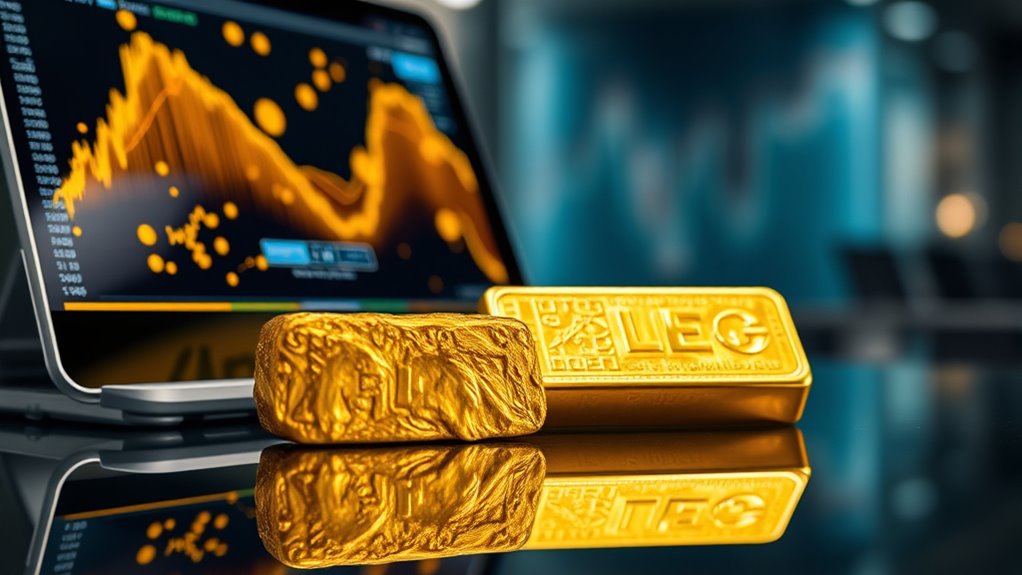Digital gold provides superior market liquidity and quicker transaction speeds than physical bullion. With online platforms, you can buy, sell, and settle trades instantly, often 24/7, without the delays of physical handling or storage concerns. Physical gold requires finding buyers, negotiating prices, and managing logistics, which slows down liquidity. If you want to understand how technology is bridging these gaps and busting liquidity myths, explore further below.
Key Takeaways
- Digital gold offers near-instant transactions during market hours, unlike physical bullion which requires seller identification and logistics.
- Blockchain technology enhances security and enables real-time settlement, increasing liquidity for digital gold.
- Online platforms facilitate 24/7 trading access globally, whereas physical bullion markets are limited by geographic and operational factors.
- Physical gold involves storage, transfer, and verification delays, reducing quick liquidity compared to digital alternatives.
- Lower transaction costs and fractional investing in digital gold support more frequent, efficient market activity versus physical bullion.

Is market liquidity for gold truly as limited as many believe? The truth is, with digital gold, liquidity is often much more accessible and efficient than you might think. During market hours, transactions happen nearly instantaneously, allowing you to buy or sell gold with minimal delays. The convenience stems from online platforms that facilitate rapid trades, bypassing the need for physical movement or verification. In contrast, physical gold sales are more variable; coins and small bars tend to sell faster than larger bars or collectible pieces, which often require more time and effort to find buyers. Since physical gold involves handling, transportation, and authentication, delays are common—especially in regions where dealer access is limited or markets are less developed. Digital gold eliminates these hurdles altogether, removing physical handling and enabling seamless transactions. Additionally, market infrastructure is continually evolving to support faster and more reliable trading processes, further enhancing liquidity. This technological advancement helps bridge the gap between physical and digital gold markets, making digital gold a more flexible option. Furthermore, digital gold platforms operate 24/7, meaning you can trade outside traditional market hours. This continuous availability boosts liquidity, giving you the flexibility to react quickly to market changes. Conversely, physical gold trading depends heavily on dealer availability and local market hours, which can restrict your ability to liquidate assets promptly. Geographic access also plays a role here; in some parts of the world, physical gold markets are less developed, further limiting instant liquidity. Digital gold’s global reach and online accessibility mean you’re not confined by physical borders, enhancing your capacity to buy or sell whenever you choose. Additionally, market accessibility is significantly improved through digital gold, making it easier for investors worldwide to participate in trading activities. Moreover, the digital infrastructure supporting these platforms continuously improves, further reducing barriers to rapid transactions. Accessibility is another key factor. Digital gold enables fractional investing, so you can purchase very small amounts, lowering entry barriers and making it easier and quicker to liquidate small holdings. Physical gold requires buying whole coins or bars, which can be pricey and less practical for quick sales. Additionally, blockchain technology and transparent online platforms improve security and trust, making you more comfortable with frequent trading. Physical gold ownership, on the other hand, demands secure storage and physical custody, which can slow down liquidity. Selling physical gold often involves finding the right buyer or dealer, negotiating prices, and managing logistics—all of which take time. The digital infrastructure supporting digital gold transactions further enhances liquidity by providing real-time price updates and instant settlement options, unlike physical gold where the process depends on physical exchanges and can be slower. Cost considerations also influence liquidity. Physical gold usually carries premiums for manufacturing and distribution, which can cut into resale value and make quick sales less appealing. Digital gold typically has lower transaction fees and premiums, supporting more frequent trades. Real-time price tracking on digital platforms helps you make timely decisions aligned with market fluctuations, unlike physical gold, where resale prices can be affected by dealer spreads or the need for specific buyers. Also, recurring storage and security fees for physical gold add costs that can hinder liquidity, whereas digital gold ownership removes these expenses, making quick transactions more feasible. Overall, digital gold’s virtual nature, combined with technological advantages, substantially enhances liquidity, challenging the misconception that gold trading is inherently slow or limited.
Frequently Asked Questions
How Does Market Liquidity Differ Between Digital Gold and Physical Bullion?
You’re curious about how market liquidity differs between digital gold and physical bullion. Digital gold offers instant online transactions, allowing you to buy or sell quickly with immediate settlement to your bank. Physical bullion, however, involves slower processes like finding buyers, verifying authenticity, and handling logistics. This makes digital gold more liquid and flexible, while physical gold’s liquidity depends on availability, storage, and market conditions, often leading to delays.
What Factors Influence Liquidity in Digital Gold Markets?
You should know that liquidity in digital gold markets depends on several key factors. Higher trading volumes and deep order books make it easier for you to buy or sell large amounts without impacting prices. Listings on reputable exchanges and active market makers boost liquidity. Clear regulations, positive investor sentiment, and reliable technology also play essential roles in ensuring you can trade smoothly and confidently in digital gold markets.
Are There Risks Related to Liquidity During Market Crashes?
During market crashes, you face liquidity risks whether holding physical or digital gold. Physical gold can become harder to sell quickly due to logistical issues, storage costs, and limited dealer access. Digital gold might face platform outages or cybersecurity threats, temporarily blocking your access. Both forms carry risks, but digital gold’s instant online transactions often make it more flexible in emergencies, helping you liquidate faster when needed most.
How Quickly Can Assets Be Liquidated in Each Form?
You want to know how fast you can liquidate assets in each form. Digital gold offers near-instant transactions online, allowing you to sell quickly at real-time market rates, often within minutes. Physical bullion takes longer due to physical exchange, verification, and transportation, which can delay liquidation from days to weeks. Digital options give you rapid access, while physical gold requires more time and effort to convert into cash or other assets.
What Role Does Market Regulation Play in Liquidity Levels?
Market regulation directly influences liquidity levels by setting rules that affect how easily assets can be bought or sold. When regulations like Basel III increase capital requirements for unallocated gold, banks face higher costs, reducing their willingness to hold or trade these assets. This decreases overall market liquidity, making it harder for you to quickly liquidate assets. Conversely, regulations promoting physical gold or high-quality assets can boost liquidity by encouraging tangible holdings.
Conclusion
So, there you have it—digital gold and physical bullion aren’t the mysterious market unicorns you once thought. Turns out, liquidity isn’t some elusive myth but a well-manicured myth-smorgasbord. Whether you prefer clicking or holding, both options offer surprises—like being able to buy and sell without turning your investment into a game of “Where’s Waldo?” So go ahead, choose your shiny weapon, and enjoy the liquidity illusion while it lasts.
Helen brings a wealth of experience in investment strategy and a deep passion for helping individuals achieve their retirement goals. With a keen understanding of market dynamics, Helen has been instrumental in shaping the vision and direction of Gold IRA Markets. She specializes in creating innovative solutions that align with our clients’ long-term investment objectives.










